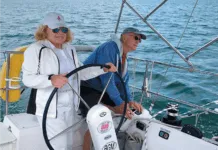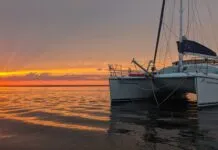With winter approaching, its time to start your list of cold-weather projects and purchases. Remember: If you will be unstopping your masts this winter, and plan on buying new sails, be sure to take the measurements that your sailmaker will needs while the mast is still up.
The Minimum Sail Inventory for Cruising
Most of us make lists of things we’d like to add to our boats. Sails, it often seem, take a second seat to this other great gear, especially the latest electronics. By filling the gap in the sail inventory (for instance, buying a 130%genoa to add to the working jib and #1 genoa headsail inventory) can make all the difference between an enjoyable sail and one in which the boat just won’t move because the right combination of sails can’t be found. Even if you have roller furling and think your one headsail can do it all, that’s not really the case when cruising.
The well-found cruising boat should carry sails for all types of weather, ranging from ghosting conditions to full-blown gales. Of course, much of the inventory will apply to those middle and more normal conditions. But shortchanging yourself by skipping storm sails or drifters means endangering the boat and crew at worst and subjecting them to excessive heel or irritating slatting at least.
The following are suggested minimum sail inventories for sloops, cutters, ketches, and yawls, including optional sails.
Sloop with single headsail:
-Mainsail Working jib
-No. 1 genoa (150%)
-No. 2 genoa (110% to 130%)
-Drifter, reacher or cruising spinnaker
-Trysail
-Storm jib
Optional:
-No. 2 jib
-Second mainsail
Note: a genoa designated as #1 or #2 does not refer to a specific percentage of foretriangle size (the LP measurement, which is a perpendicular from the luff intersecting the clew, is used in determining 130%, 150%, etc.). Rather, #1 or #2 refers to the largest headsail on board, next largest, and so on.
Cutter and double-headsail sloops:
-Mainsail
-Yankee jib
-Staysail with reef points
-Trysail
-Storm jib
-Drifter, reacher, or cruising spinnaker
Optional:
-No. 1 Yankee jib
-No. 3 Yankee jib
-Small or storm staysail
Ketch or Yawl:
-Mainsail Mizzen working jib
-No. 1 genoa (150%)
-No. 2 genoa (110% to 130%)
-Drifter, reacher, or cruising spinnaker
-Trysail Storm jib
Optional:
-No. 2 jib
-Mizzen staysail
To get additional information and tips on upgrading your boats rig and sails, purchase Spurr’s Guide to Upgrading Your Cruising Sailboat today!




































